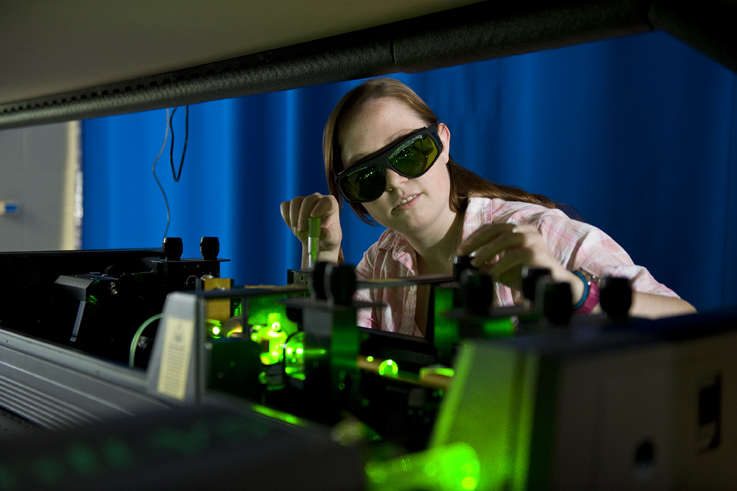WSU Terahertz and Ultrafast Photonics
Research Group -- Introduction
WSU Terahertz and Ultrafast Photonics
Research Group -- Introduction
|
|
Introduction to terahertz radiation and ultrafast photonics
Our research focuses on high frequencies and short time spans. 1 Terahertz is equal to 1E12 Hz (1/second) and is equivalent to a wavelength of 300 microns. The lasers that our group uses are even faster as they emit pulses of light that exist for less than 100 femtoseconds, or in other words, 0.000000000000100 seconds. We use these shorts bursts of light, which have a wavelength in the near-infrared, to generate terahertz frequency pulses. In the images below, you can see several of our students working with one of our ultrafast laser systems. These are actually a series of 3 laser systems where the first two are "pump" lasers used to drive the final laser, Titanium:Sapphire oscillator.
To learn more about the capabilities of this and our other ultrafast lasers, check out the "THz Facilities" link!




The section of the electromagnetic spectrum spanning from 100 GHz to 30 THz is often referred to as the terahertz (THz) gap (0.1-10 THz). This region remained relatively unexplored until developments in technologies such as ultrafast (< 100 fs) lasers provided techniques for the generation and detection of pulsed THz radiation. The far left figure above depicts the layout for a conventional terahertz time-domain spectroscopy system. In our group, our standard method of generating and detecting terahertz pulses is to use our ultrafast lasers to excite/trigger photoconductive antennas. There are other methods such as optical rectification (generation) and electro-optic detection that we sometimes employ depending on the system and the experiment. Our group also has access to a quantum cascade laser, a novel powerful continuous-wave THz source. We also collaborate with Dr. Douglas Petkie's group at Wright State University. His group specializes in sub-mm and terahertz wave spectroscopy, imaging, and sensor application development using continuous-wave THz sources using technology such as diodes and back-ward wave oscillators.
The diagram on the above right shows a typical measured THz pulse in the time-domain and its representation in the frequency domain (obtained via FFT). The shortness of the time-domain pulse and the resulting bandwidth in the frequency domain is a function of the pulse width of the ultrafast laser and the source/detector scheme. One of our sources is based on a 15 fs ultrafast pulsed laser which combined with some innovative system designs gives us a bandwidth exceeding 6-7 THz. Demonstrated application areas for THz imaging and spectroscopy include security, semiconductor spectroscopy, and biomedical imaging and diagnostics. Terahertz time-domain spectroscopy (THz-TDS), with its broad fractional bandwidth and sub-picosecond time resolution, offers an effective method of characterizing the frequency dependent absorption, refractive index, conductivity, and other parameters of a variety of materials. A significant reason for all of the recent interest in working with terahertz radiation derives from the unique properties that many substances exhibit at terahertz frequencies as compared to other segments of the electromagnetic spectrum. In fact, most dielectric materials are transparent to terahertz radiation, while metals are opaque. This alone makes terahertz an attractive technology for non-destructive evaluation applications. More important to the work proposed here is that many solids, liquids, and gases exhibit unique spectroscopic “fingerprints” at terahertz frequencies.
Research projects in our group span a variety of topics from multiple disciplines and fall into one of several categories (some projects even qualify for more than one):
- Terahertz time-domain spectroscopy of novel semiconductor materials.
- Terahertz time-domain spectroscopic imaging.
- The scattering of terahertz radiation from oriented nanostructured materials.
- Terahertz spectroscopy of proteins.
- Terahertz-based non-destructive analysis of corrision and other faults on metal surfaces.
- Terahertz-based combustion diagnostics and imaging.
- Terahertz near-field microscopy and waveguide development.
- Finite element method (FEM) and finite difference time-domain (FDTD) simulations of microwave, THz, and IR devices and physical phenomena.
For more specific information about these topics, please go to the THz Research page on this website.
For more information about terahertz science and technology, please refer to the following webpages:
- The Mittleman Research Group at Rice University.
- The Terahertz Science and Technology Network.
- The Rensselaer Center for Terahertz Research.
- The Ultrafast THz Optoelectronic Laboratory at Oklahoma State University.
- The Ohio State University Department of Physics Microwave Laboratory.
- The Terahertz Collaborative Research Center at IDCAST.
There are several more terahertz and ultrafast links on the the THz Research page.

